Accepted Scientific Name: Lithops bromfieldii L. Bolus
Notes Mesembryanthemum [H.M.L. Bolus] 2: 452. 1934 [23 May 1934] L. Bolus
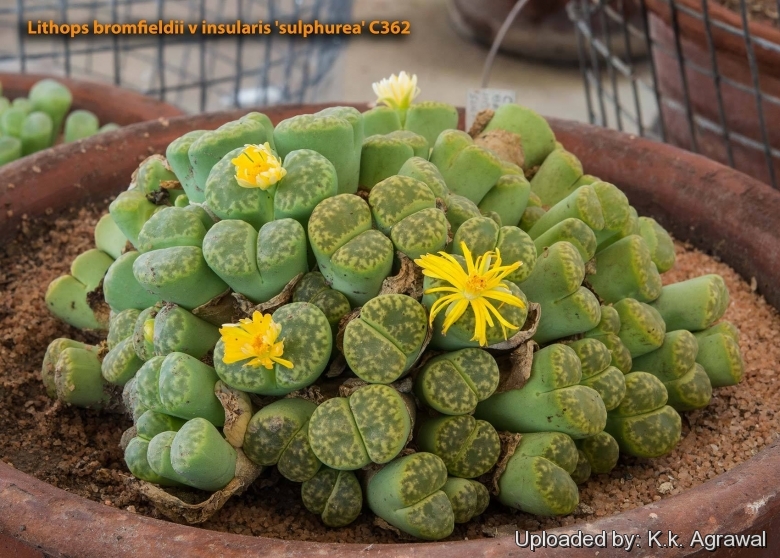
Lithops bromfieldii var. sulphurea C362 Photo by: K.k. Agrawal
Origin and Habitat: Japanese cultivar obtained by Yasuhiko Shimada.
Synonyms:
See all synonyms of Lithops bromfieldii
back
Accepted name in llifle Database:Lithops bromfieldii L. BolusNotes Mesembryanthemum [H.M.L. Bolus] 2: 452. 1934 [23 May 1934]Synonymy: 26
- Lithops bromfieldii L. Bolus
- Lithops bromfieldii C040 TL: 15 km ENE of Upington, South Africa
- Lithops bromfieldii C041 15 km ENE of Upington, South Africa
- Lithops bromfieldii C279 45 km E of Upington, South Africa
- Lithops bromfieldii C348 20km East of Upington, Cape Province, South Africa
- Lithops bromfieldii C368 25 km SE of Upington, South Africa
- Lithops bromfieldii var. glaudinae (de Boer) D.T.Cole
- Lithops bromfieldii var. glaudinae C116 TL: 70 km WNW of Griquatown, South Africa
- Lithops bromfieldii var. glaudinae C382 70 km W of Griquatown, South Africa
- Lithops bromfieldii var. glaudinae C393 70 km NW of Griquatown, South Africa
- Lithops bromfieldii var. insularis (L. Bolus) B.Fearn
- Lithops bromfieldii var. insularis C042 15 km E of Keimoes, South Africa
- Lithops bromfieldii var. insularis C043 15 km E of Keimoes, South Africa
- Lithops bromfieldii var. insularis C057 10 km NE of Keimoes, South Africa
- Lithops bromfieldii var. menellii (L. Bolus) B.Fearn
- Lithops bromfieldii var. menellii C044 TL: 25 km SSW of Upington, South Africa
- Lithops bromfieldii var. menellii C283 20 km SSW of Upington, South Africa
- Lithops bromfieldii var. sulphurea C362 D.T.Cole
- Lithops rooi hort. ex Oesterr.
- Lithops rouxii hort. ex Oesterr.
- Lithops upingtonensis L. Bolus
Cultivars
(2):
back
Common Names include:
ENGLISH: Living stone, Stone Plant
JAPANESE (日本語): Ki-Meigen
Description: Lithops bromfieldiiSN|12915]]SN|12915]] var. sulphurea C362 is one of the most sought-after Lithops cultivars in which the leaves have lost their brown pigment resulting in various shades of green, opaque creamy yellow-green or lime green with numerous tiny darker green blotches on the face. The bodies are small and often odd looking, in particular the variation in the size of the various heads in relation to one another. It is a fast clumper that can produce readily large mound with dozen of heads. The flowers are yellow. This cultivar comes true from seed.
Subspecies, varieties, forms and cultivars of plants belonging to the Lithops bromfieldii group
 Lithops bromfieldii L. Bolus: (var. bromfieldii) Medium sized with a bullate top surface and generally reddish coloured. Distribution: Cape province.
Lithops bromfieldii L. Bolus: (var. bromfieldii) Medium sized with a bullate top surface and generally reddish coloured. Distribution: Cape province. Lithops bromfieldii C040 TL: 15 km ENE of Upington, South Africa: rusty orange, red lines.
Lithops bromfieldii C040 TL: 15 km ENE of Upington, South Africa: rusty orange, red lines.- Lithops bromfieldii C041 15 km ENE of Upington, South Africa: dark red lines & dots.
 Lithops bromfieldii C279 45 km E of Upington, South Africa: like red-veined marble.
Lithops bromfieldii C279 45 km E of Upington, South Africa: like red-veined marble. Lithops bromfieldii C348 20km East of Upington, Cape Province, South Africa: variable, dark brown to milky green.
Lithops bromfieldii C348 20km East of Upington, Cape Province, South Africa: variable, dark brown to milky green. Lithops bromfieldii C368 25 km SE of Upington, South Africa: mostly rusty red
Lithops bromfieldii C368 25 km SE of Upington, South Africa: mostly rusty red- Lithops bromfieldii var. glaudinae (de Boer) D.T.Cole: Medium sized characterized by many dusky dots with a shining metallic reflex. Rubrications dull blood-red.
 Lithops bromfieldii var. glaudinae C116 TL: 70 km WNW of Griquatown, South Africa: graphitic luster.
Lithops bromfieldii var. glaudinae C116 TL: 70 km WNW of Griquatown, South Africa: graphitic luster. Lithops bromfieldii var. glaudinae C382 70 km W of Griquatown, South Africa: unusual form.
Lithops bromfieldii var. glaudinae C382 70 km W of Griquatown, South Africa: unusual form.- Lithops bromfieldii var. glaudinae C393 70 km NW of Griquatown, South Africa
- Lithops bromfieldii var. glaudinae cv. Rubroroseus
 Lithops bromfieldii var. insularis (L. Bolus) B.Fearn: This species is characterized by impressed valley-like channels, raised islands, and bold rubrications and is quite variable
Lithops bromfieldii var. insularis (L. Bolus) B.Fearn: This species is characterized by impressed valley-like channels, raised islands, and bold rubrications and is quite variable- Lithops bromfieldii var. insularis C042 15 km E of Keimoes, South Africa: dusky, with red dots.
 Lithops bromfieldii var. insularis C043 15 km E of Keimoes, South Africa
Lithops bromfieldii var. insularis C043 15 km E of Keimoes, South Africa Lithops bromfieldii var. insularis C057 10 km NE of Keimoes, South Africa: grey brown top, red lines.
Lithops bromfieldii var. insularis C057 10 km NE of Keimoes, South Africa: grey brown top, red lines. Lithops bromfieldii var. menellii (L. Bolus) B.Fearn: Medium sized form with rugose surface, pinkish-grey facial colour and very dark rubrications.
Lithops bromfieldii var. menellii (L. Bolus) B.Fearn: Medium sized form with rugose surface, pinkish-grey facial colour and very dark rubrications. Lithops bromfieldii var. menellii C044 TL: 25 km SSW of Upington, South Africa: grey brown top, red lines.
Lithops bromfieldii var. menellii C044 TL: 25 km SSW of Upington, South Africa: grey brown top, red lines. Lithops bromfieldii var. menellii C283 20 km SSW of Upington, South Africa: Hebrew script.
Lithops bromfieldii var. menellii C283 20 km SSW of Upington, South Africa: Hebrew script. Lithops bromfieldii var. mennellii cv. Pale Selection (MG 1561.8)
Lithops bromfieldii var. mennellii cv. Pale Selection (MG 1561.8) Lithops bromfieldii var. sulphurea C362 D.T.Cole: Small to medium sized green monster.
Lithops bromfieldii var. sulphurea C362 D.T.Cole: Small to medium sized green monster.
Bibliography: Major refences and further lectures
1) Heidrun E. K. Hartmann “Aizoaceae F – Z” Springer 2002
2) Desmond T. Cole & Naureen A. Cole, Uwe Beyer, Yves Delange “Les Lithops” SUCCULENTES Spécial 2008 AIAPS (now Terra seca). 2008
3) Desmond T. Cole & Naureen A. Cole “LITHOPS Flowering Stones” Cactus & Co. Libri. 2005
4) Yasuhiko Shimada“The Genus Lithops” Dobun Shoin. 2001
5) Rudolf Heine “Lithops - Lebende Steine” Neumann Verlag. 1986
6) Bernd Schlösser “Lithops – Lebende Steine” Praktische Anleitung für die Zimmerkultur. Bussiness Point MEDIA. 2000
7) Steven A. Hammer “Lithops – Treasures of the veld” British Cactus and Succulent Society. 1999
8) Desmond T. Cole “Lithops – Flowering Stones” Acorn Books CC. 1988
9) Rudolf Heine “Lithops – lebende Steine” Neumann Verlag. 1986
10) David L. Sprechman “Lithops” Associated University Presses, Inc. 1970
11) Gert Cornelius Nel “Lithops: Plantae succulantae, rarissimae, in terra obscuratae, e famailia Aizoaceae, ex Africa australi” Hortors Limited, South Africa, 1946
12) Achim Hecktheuer “Mesembs, mehr als nur Lithops” Books on Demand GmbH Norderstedt. 2008
13) Werner Rauh “Die grossartige Welt der Sukkulenten” Hamburg and Berlin: Verlag Paul Parey, 1966
14) Stuart Max Walters “The European Garden Flora: Dicotyledons (Part I)” Cambridge University Press, 1989
15) Gordon D. Rowley “The illustrated encyclopedia of succulents” Crown Publishers, 01/Aug/1978
16) Steven A. Hammer “Lithops: Joyaux du veld” Editions Quae, 25/nov/2010
17) Gustav Schwantes "Flowering Stones and Mid-day Flowers: A Book for Plant and Nature Lovers on the Mesembryanthemaceae" Ernest Benn, 1957
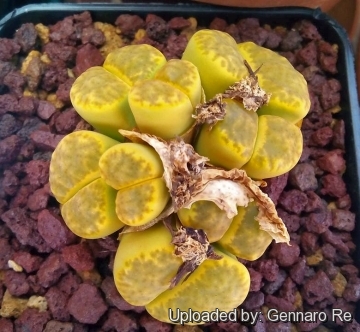 Lithops bromfieldii var. sulphurea C362 Photo by: Gennaro Re
Lithops bromfieldii var. sulphurea C362 Photo by: Gennaro Re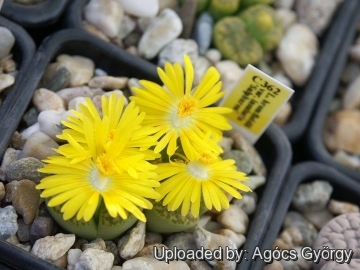 Lithops bromfieldii var. sulphurea C362 Photo by: Agócs György
Lithops bromfieldii var. sulphurea C362 Photo by: Agócs György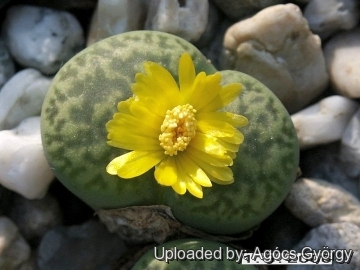 Lithops bromfieldii var. sulphurea C362 Photo by: Agócs György
Lithops bromfieldii var. sulphurea C362 Photo by: Agócs György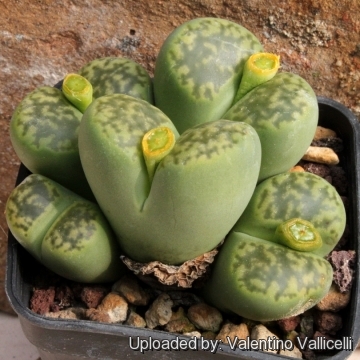 Lithops bromfieldii var. sulphurea C362 Photo by: Valentino Vallicelli
Lithops bromfieldii var. sulphurea C362 Photo by: Valentino Vallicelli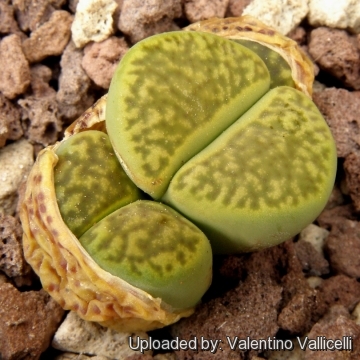 Lithops bromfieldii var. sulphurea C362 Photo by: Valentino Vallicelli
Lithops bromfieldii var. sulphurea C362 Photo by: Valentino Vallicelli Lithops bromfieldii var. sulphurea C362 Photo by: Valentino Vallicelli
Lithops bromfieldii var. sulphurea C362 Photo by: Valentino Vallicelli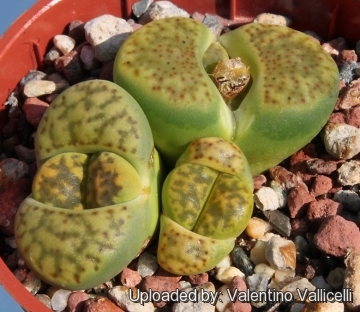 Lithops bromfieldii var. sulphurea C362 Photo by: Valentino Vallicelli
Lithops bromfieldii var. sulphurea C362 Photo by: Valentino Vallicelli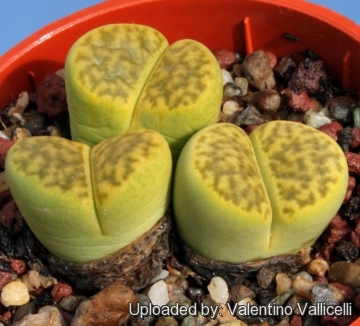 Lithops bromfieldii var. sulphurea C362 Photo by: Valentino Vallicelli
Lithops bromfieldii var. sulphurea C362 Photo by: Valentino VallicelliCultivation and Propagation: The Lithops (a.k.a. Living Stones) are some of the world's most fascinating plants and are sought by the collector of succulent plants. Paying attention to the particular growing requirement of Lithops is especially important. If you provide the Lithops with the right conditions, they will reward you with their unique shape, size, colour and a proliferation of blooms in autumn. However, Lithops are tricky plants that are very particular about their growing conditions and require the right maintenance in order to keep happy. But don't be afraid even the best growers have plants that mysteriously dry up, or leave during the night. While Lithops are picky about their care, if you are patient and remember the basics, your efforts will be rewarded. Being small plants, a representative collection can be grown on a patio table, a sunny windowsill or a shelf in the greenhouse.
Growing rate: Slow growing for a mesemb.
Soil: They grow best in an open mineral, sandy-gritty soil and requires good drainage as they are prone to root rot. They can grow outdoor in sunny, dry, rock crevices (protection against winter wet is required) They can also be cultivated in alpine house, in poor, drained soil.
Repotting: They may stay in the same pot for many years. Plants grown in larger containers have frequently relatively poor flowers. Flowers might improve when the plants are given their own, small individual pots.
Watering They Require little water otherwise the epidermis breaks (resulting in unsightly scars). The basic cultivation routine is: Stop watering after flowering. Start watering after the old leaves are completely dry (usually late March or Early April). Water freely during the growing season, soak the compost fully but allow it to dry out between waterings. In the winter season the plant doesn’t need watering, the plant in this time extracts water from the outer succulent leaves, allowing them to shrivel away, relocating water to the rest of the plant and to the new leaves that form during this period. If grown in a container, bottom watering by immersing the container is recommended. Water sparingly only when warm, no water when cold. Nearly all problems occur as a result of overwatering and poor ventilation, especially when weather conditions are dull and cool or very humid. They must have very dry atmosphere.
Fertilization: Feed them once during the growing season with a fertilizer specifically formulated for cactus and succulents (high potash fertilizer with a dilute low nitrogen), including all micro nutrients and trace elements diluted to ½ the strength recommended on the label. They thrive in poor soils and need a limited supplies of fertilizer to avoid the plants developing excess vegetation, which is easily attacked by fungal diseases. Some growers fertilize frequently, some hardly ever. However, for the highly succulent mesembs, (Lithops, Conophytums, etc.) fertilization is not really necessary.
Light: They prefer a very bright situation and in winter they need the maximum amount of light you are able to give them, but keep more cool and partially shaded in summer. The only exception to this is seedlings in their first year that enjoy a shades place. Such tiny plants can easily get scorched or broiled and their appearance spoiled (this may not matter in the wild, where the Lithops have probably shrunk into the ground and becomes covered with sands). Outdoor (Lithops prefer full sun, with some shade in the hottest summer months. High levels of light are needed in autumn to flower and for good plant development. The low intensity of sun light during the growing season of this species generally prevents the white flower flowers from opening.
Special Advice: Lithops are best planted in a sunny and airy part of the greenhouse, and not too close to the glass roof or sides of the house as the plants can overheat during hot spells.
Hardiness: They require a minimum temperature 5°C (But will take a light frost and are hardy down to -7° C for short periods if they are in dry soil). USDA zones 9A – 11.
Uses: Container, rock garden.
Pests & diseases: Lithops may be attractive to a variety of insects, but plants in good condition should be nearly pest-free, particularly if they are grown in a mineral potting-mix, with good exposure and ventilation. Nonetheless, there are several pests to watch for:
- Red spiders: they may be effectively rubbed up by misting the vulnerable plants every day.
- Mealy bugs: occasianlly they develop aerial into the new leaves and flowers with disfiguring results, but the worst types develop underground on the roots and are invisible except by their effects.
- Sciara Flies: they are one of the major problems for seedlings. It is a good practice to mulch your seedlings with a layer of grit, which will strongly discourage the flies.
- Scales, thrips and aphids: (they are rarely a problem.)
It is wise to treat your whole collection with a systemic insecticide twice a year in spring and autumn.
- Rot: it is only a minor problem with mesembs if the plants are watered and “aired” correctly. If they are not, fungicides won't help all that much.
Remarks: After flowering in the autumn and extending through winter season the plant doesn’t need watering, but they will still be growing, the new bodies will be increasing in size extracting water from the outer succulent leaves, allowing them to shrivel away. In fact the plant in this time extracts water and nutrient stored in the outer succulent leaves, allowing them to dehydrate relocating the water to the rest of the plant and to the new leaves that form during this period until the old leaves are reduced to nothing more than "thin papery shells".
Propagation: Seed or (or rarely) cuttings. The small seeds can be sown in pots of fine, well-drained sand, any time during the spring and summer months when temperatures are warm. Cover the seeds with a very fine layer of grit and water from below with a fungicide to prevent damping off. For the first 3-4 days cover the pots with a sheet of glass/clear perspex to keep the humidity levels high. Remove the glass and replace it with light shadecloth and mist once or twice a day for the next two weeks after which most seeds should have germinated. From then on mistings can be reduced to every second and then every third day as the little plants grow. Take the cuttings from a grown-up mother plant. Each cutting must contain one or more heads along with a fraction of root and permit them to dry out a couple of days, lay the cuttings on the soil and insert the stem end partially into the soil. Try to keep the cutting somewhat upright so that the roots are able to grow downward. It is relatively difficult to root Lithops from cuttings and generally pointless as well, so quick are they from seed.
Comment: Improvement of Lithops characteristics: Some growers (but not all!!) think it is very intriguing to reinforce any characteristic of cultivated Lithops of by crossing two similar selected plants and then back-crossing with the mother plant. This way we can eventually get some interesting results. Of course, many of the nicest Lithops we grow in cultivation have already been selected over time. However many Lithops are already nice plants which can’t really be improved, on the other hand one could try to improve the colour or the markings etc. Now if we have two particular plants we may attempt to breed between them and can maybe get a whole improved population and then select some better offspring to continue the selection.
Seed production: Plants can be hand pollinated, using a small paint brush. Remember always to cross different clones as the plants are self-sterile. The seed will remain viable for many years provided it is stored in a cool dry place.
Your Photos
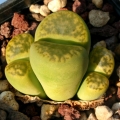
by Valentino Vallicelli

by Valentino Vallicelli
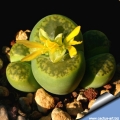
by Cactus Art
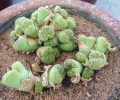
by K.k. Agrawal
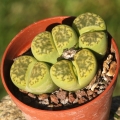
by Valentino Vallicelli
























